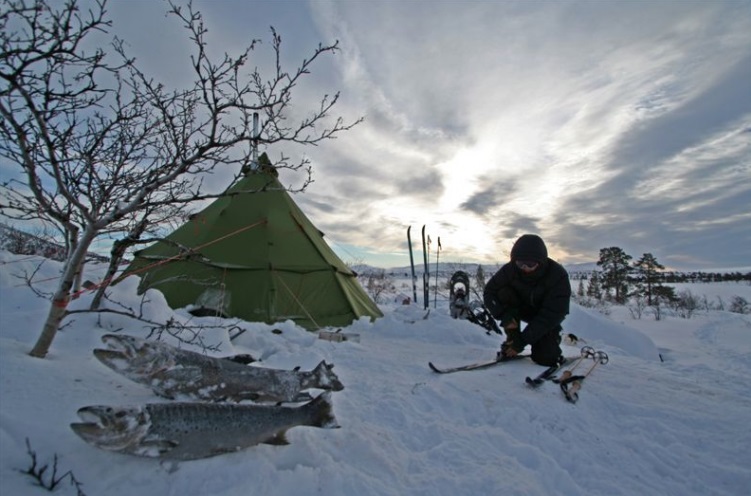1. How to choose a tent?
Looking through our Helsport pages will help you to choose the right tent for you. Generally speaking, you can say that Tunnel models are always lighter than dome or Tunnel/Dome tents. Poles and zippers make your tent heavier - since the fabric is very light on all the models, poles, pegs, zippers in openings etc make a difference to the weight more than if, for example, you go for a three person tent instead of a two, or one with a vestibule instead of one without.
2. Do I need a footprint?
Our tent floors are made of the best available material so they will do the job. Footprints are not absolutely necessary but they can be quite good to have. A footprint obviously protects the groundsheet from damage and prolongs its lifespan but you have to be careful so that you don’t get sand between your footprint and the tent floor as this can lead to more abrasion. Older groundsheets get extra protection if you use a groundsheet.
The strongest reason for a footprint, the way we see it, is that it protects you from moisture in the ground which keeps condensation at a lower level and also protects your equipment against moisture. If you make some trips in a wet and marshy area or in an environment with big differences in temperature in the course of the day, it is very advisable to use a footprint
3. Why do you not tape the seams on all your tents?
On our PRO and X-TREM series tents we use silicone coated (on both sides!) fabrics to obtain the highest tear strength possible. These fabrics are highly superior to ordinary polyurethane coated fabrics, but silicone coatings do not provide the adhesion necessary for good taping (It is possible to tape it, but is does not work well at cold temperatures, that is below -20C). We have consciously chosen not to tape the seams to be able to use these materials. We do also use a special polyester thread with cotton spun around it. When this thread gets wet it expands and automatically seals the seam against leakage. The first time you use your tent you might, in seldom cases, experience that small drops of water appear on the inside of the seam - this is perfectly normal and is only the water that can get through in the very short period as the cotton expands.
4. What does 3-season tent mean?
By three season we mean a tent that is primarily built for use in spring, summer and fall - although this is a modified truth. They do work in the winter as well, but for longer winter tours you should definitely opt for an X-TREM tent with snow skirts and additional guy lines to be able to secure it in the best possible way in the winter. But if you feel like doing some winter tours go ahead - just remember that it is even more important to dig in a 3-season tent in the snow to protect it and/or to build a snow wall on the windward side of your tent to protect it.
5. Why is there a seam on the floor of my tent?
We are limited by the width in which tent floor fabric is available. In theory we could make tents with an inner width of 130 cm without any seams in the groundsheet, but we would not be able to go up the sides using one piece and would have to have the seams in the corners. Larger tents always have a seam. We have chosen a seam in the groundsheet so that we can create a proper tub floor in all our tents.
6. Why are there Storm/Snow Skirts on your X-TREM series tents, do I really need them?
Yes! A real winter and expedition tent should have them and they should be on there so that you don’t have to think about it and sew them on at a later stage. All our models go all the way to the ground, so also the PRO-series tents do work well in the winter since you then dig the tent into the snow. Having the outer “seal” at ground level is a must for a tent to work well in winter conditions with driving snow and strong winds. But as everybody knows that has been out in the winter, wind can do a lot to transform a landscape and transport the snow away so it is not always that you have enough snow to dig in. To stabilize a tent in snowy conditions there is nothing that beats storm/snow skirts. They really fix your tent to the ground and prevents drifting snow from getting into the tent. To really secure your tent in the winter it is essential to use snow pegs. When you have used a tent in bad winter weather with snow/storm skirts you will not want to have one without them again.
7. Why does the Mosquito netting have such a fine mesh?
The mosquito netting is made of such a fine mesh so that nothing will be able to get through. Here in Norway we have a lot of mosquito’s, aswell as the smaller black flies in the summer. You do not want to share your tent with them - no matter how lonely you might feel, even on long solo tours in the mountains. The netting is so fine that it actually prevents the airflow a little bit, but it just has to be that way. We also only use grey netting so that you can see through it better and have a true colour view.
8. Can I use a stove inside my tent?
One has to be extremely cautious with a stove, but you may still want to be able to prepare your food inside when the weather is less than hospitable. This can be done if you are careful.
In the bigger tents, and the camp versions of the smaller ones, a stove can be operated with reasonable safety margins. Be careful with pressure multifuel stoves - they can flare up in the priming stage or shortly after, with flames that are difficult to control. Stoves burning methylated spirits have a habit of flaring as well when you take off the saucepan. With these stoves the flame is difficult to control and therefore a little risky. The safest and best thing is to keep your stove outside your tent when possible, both for safety reasons and to keep condensation inside as low as possible. Of course, the issue with condensation doesn’t apply to our Gjende tent.
9. How do I store and take care of my tent when not on tour?
The best way to store a tent is to hang it in a cool and dry place. It is important to make sure that the tent is properly dry before it is packed away - if you cannot hang it to dry, you could for example spread it out over a couple of chairs. Before packing it away, it should be cleaned and checked for damage. Don’t forget the poles - make sure they do not have any sharp edges at the ends which could damage the tent material. Also, remember to clean and check the poles and the pegs for damage - cleaning is extra important if you have been using your tent close to saltwater, such as when sea kayaking etc.
10. I have had my tent for quite some time now and I wonder if I can reproof the fabric. Is there a need for it?
The tent fabrics we use are waterproof because of a coating. Over the years, out in sun, snow and wind, they might lose some of their repellent quality on the outside but this does not affect the waterproofness. Older and extremely worn fabrics with reduced waterproofness cannot easily be “revived” to their original state. An impregnating treatment however will help the outer tent fabric to repel rainwater - please contact us for more information on suitable treatments for your tent. A worn tent floor and/or inner tent, however, can be purchased from us.
11. Do you service and repair tents?
Of course we do. A product that last long creates a lesser impact on the environment so we want to keep our products “alive” as long as possible. We perform all repairs at our head office and warehouse in Norway. We perform all thinkable repairs at the lowest price possible. We can also replace groundsheets, put on storm/snow skirts, make an extra entrance etc. But remember that all our X-TREM models come with the storm/snow skirt and are really made for the harshest climates Mother Nature can throw at you and also have the extra guy lines etc that you need to really secure it. Talk to your local dealer if you require any service or repairs, and they will refer to us on your behalf.
12. Is it safe to make an open fire in the “Lavvu?
Yes it is, but of course you have to take care and make as small a fire as possible. The flame retardant fabric in the lavvus works very well, but it is there to prevent the tent from catching fire and NOT so that one can make a bonfire inside it. It is always better to use the oven or the burner - the former is definitely the best option since you also minimize the amount of smoke in the tent, which leads to a much nicer tent experience. But if you want to go” back to the roots” and make a small fire, go ahead but take care!







